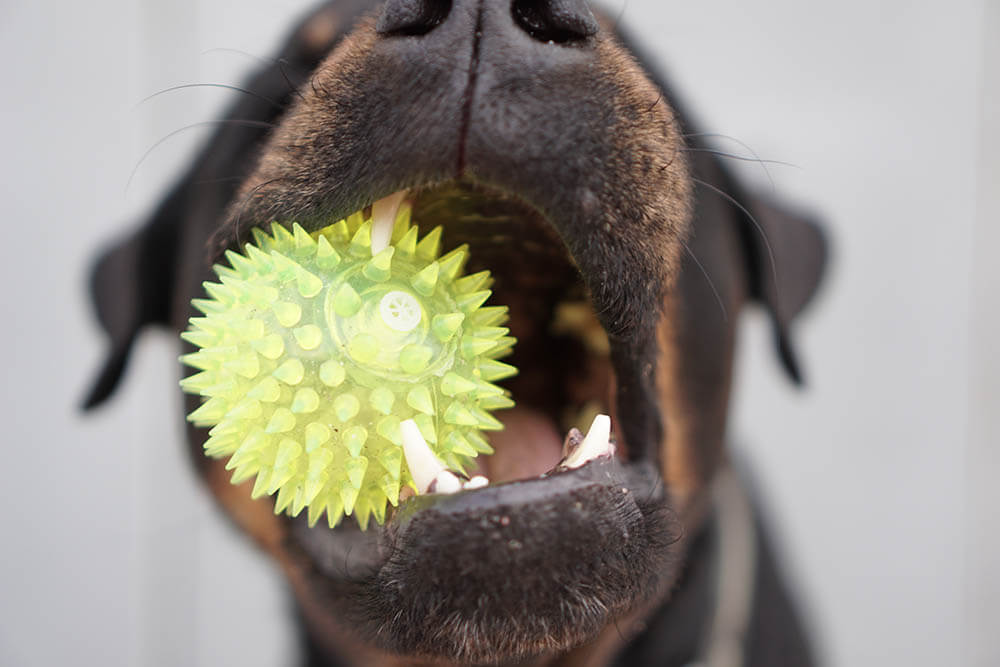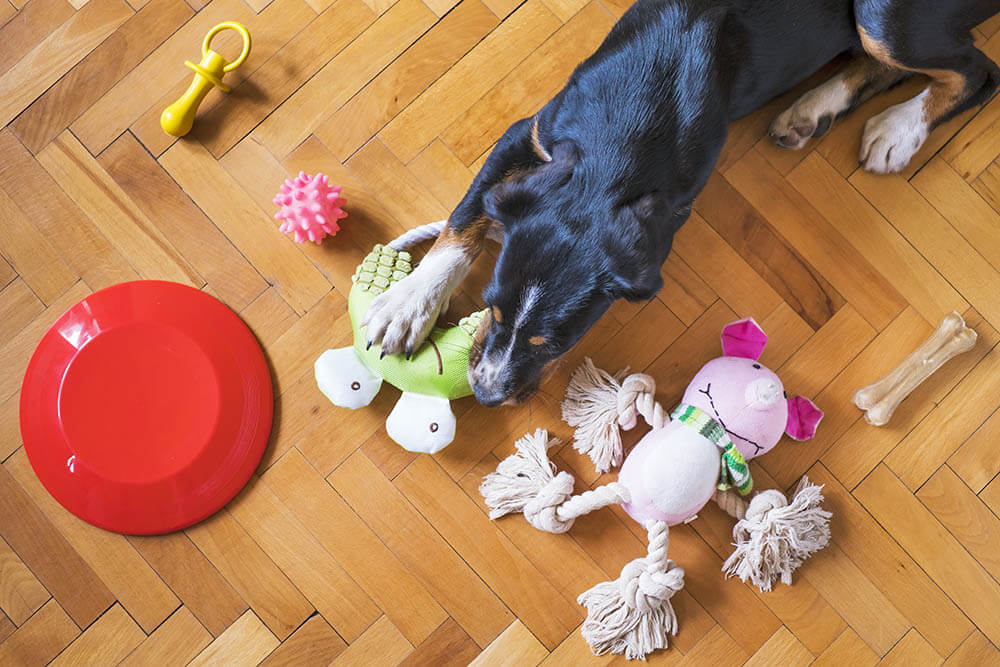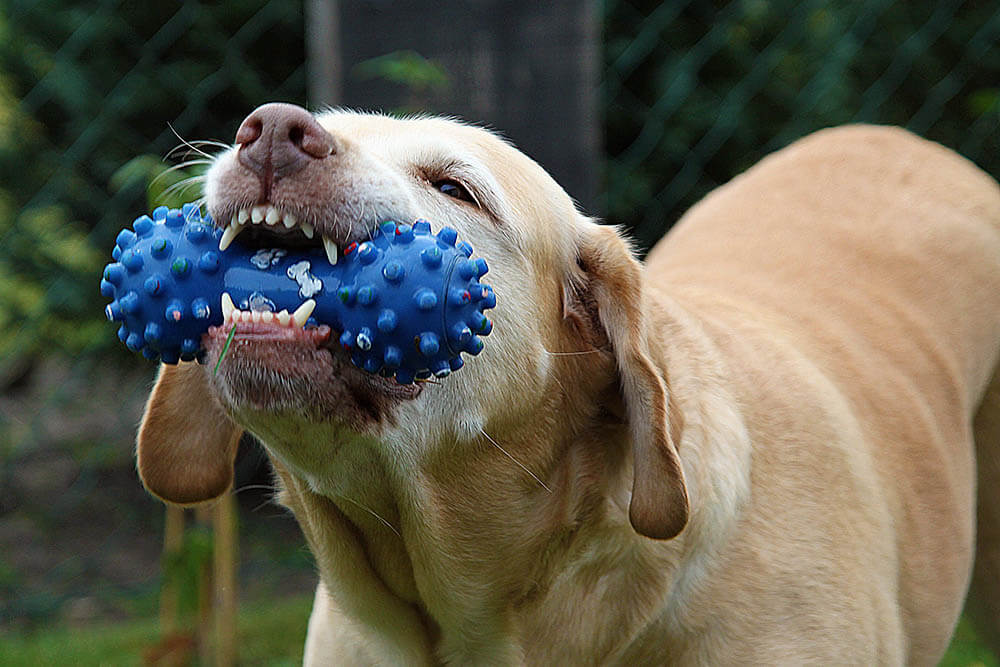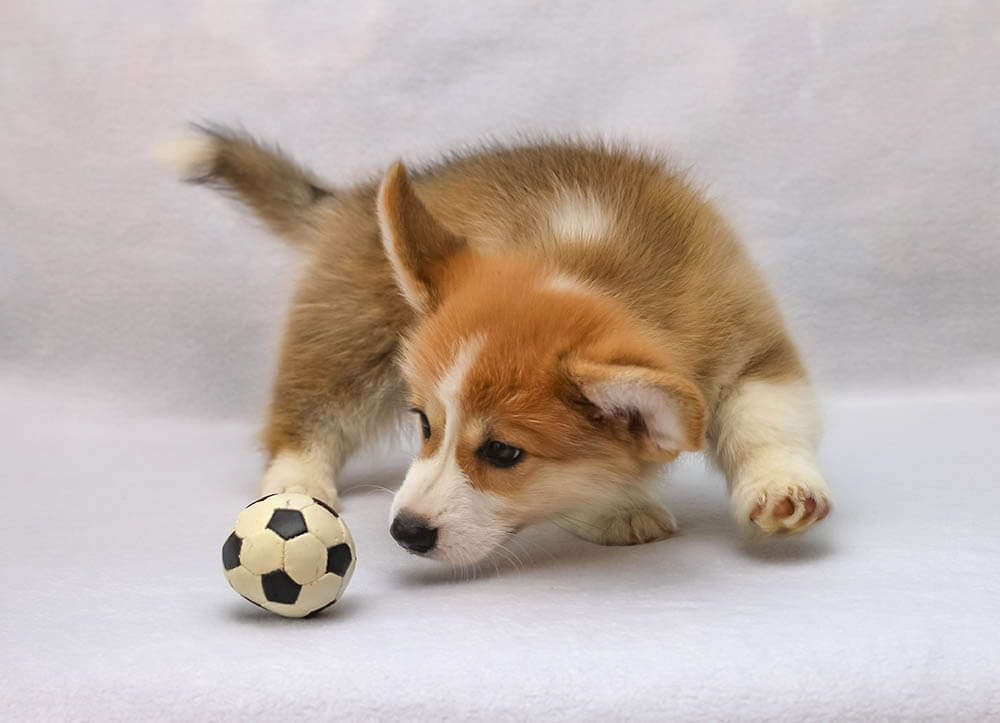Dogs love toys of all kinds, from those that bounce to those they can play tug-of-war with. But if there’s one toy our canine pals take particular delight in, it’s the squeaky toy.
But why, exactly, do dogs love squeaky toys so much? What is it about these products that engage them so fully?
Keep reading to find out!

4 Main Reasons Why Dogs Like Squeaky Toys
Below, we discuss the 4 main reasons why dogs enjoy squeaky toys.
1. Prey drive
Modern canines inherited many characteristics from their wild ancestors, including the predatory instinct to hunt down small animals for food.
And what do small, squeaky toys look and sound like to dogs? That’s right – tiny prey animals. This is especially true of toys designed to look like creatures, such as those with legs, heads, and fur.
When a dog sees a toy that reminds them of prey, the part of their brain that wants to rip and tear at tiny, defenseless animals goes into overdrive. In their excitement, they’ll seize the toy in their jaws, shake it violently, and chew it with such passion that said toy produces high-pitched squeaks resembling the desperate screaming of a dying critter.
Yes, your dog enjoys squeaky toys because they satisfy the primal canine urge to murder prey.
This explains why dogs with a particularly strong prey drive, such as those bred to hunt small game, are more likely to enjoy squeaky toys than other breeds. Such dogs may even destroy their toys to complete their fantasy of annihilating their victims.
Examples of dogs that may shred a squeaky toy to pieces include hunting breeds like the Jack Russell Terrier, Irish Setter, and German Shorthaired Pointer. Dogs with low prey drive – such as Great Pyrenees, Pomeranians, and pugs – usually content themselves with making their toys squeak.
2. Instant gratification
We’ve established that dogs like squeaky toys because the sounds they make resemble the agonizing shrieks of animals caught in the jaws of death.
Well, there’s another reason those noises bring your dog joy (though it’s also connected to the prey drive thing). When a dog is playing, the action of biting down on the toy produces an immediate positive response in the form of a squeak (i.e. a dying animal’s screech). This triggers their brain to release dopamine, a chemical that gives them feelings of joy and well-being. The dog is therefore encouraged to keep on chewing the toy to keep receiving such rewards.
3. Attention
Because your dog loves you, they derive pleasure from making you happy.
If you laugh, smile, or behave in any other positive way every time your dog makes their toy squeak, they’ll learn that they can bring you joy by engaging in make-the-toy-squeak behavior. They’ll then repeat this behavior because making you happy makes them happy.
Of course, they’ll also make the toy squeak to gain your attention whenever they want you to interact with them, such as when they’d like you to join them in play.
4. Chewing
Dogs find it fun to gnaw on things, so it’s no surprise they love chew toys.
Young puppies, in particular, bite things to explore the world, entertain themselves, and relieve the soreness caused by teething. Soft rubber toys are good for them.
Adult dogs with significant bite strength are better off chomping on tougher toys, such as those made of vinyl, plastic, or heavy rubber.
Keep in mind that a dog’s preferences rarely stay the same. For example, a dog may find themselves enjoying hard chew toys less and less as they grow older.

The Benefits of Playing With Toys
Whether your pooch has squeaky or non-squeaky toys, playing with toys benefits dogs in various ways.
1. Toys provide entertainment
Dogs need regular physical and mental stimulation. Otherwise, they get bored and unhappy, both of which can encourage strange and/or destructive behaviors. So unless you want your dog to start nibbling on your shoes, it’s a good idea to give them toys to play with.
Squeaky toys are particularly fun. They allow your dog to work their jaw and simulate predatory behavior whenever they pounce on the toy or carry it around in their mouth. This means your dog gets both physical and mental exercise!
2. Toys improve dental health
Having too much plaque makes a dog more susceptible to tooth decay.
Thankfully, chewing toys is good for your dog’s dental health as it prevents the significant build-up of plaque. This keeps the teeth and gums healthy.
There are even chews, treats, and foods created specifically to improve dental health. Some varieties of dental diets and treats can reduce plaque by almost 70% through the simple mechanical act of chewing, which scrapes the plaque off the teeth. Others are coated with anti-plaque chemical agents, an example being polyphosphate, which can reduce tartar by 55%.
An organization called the Veterinary Oral Health Council (VOHC) examines pet products to ensure they meet standards for plaque or tartar reduction. To become approved by the VOHC, chews, treats, and foods must be capable of reducing tartar or plaque by 10% or more. If the product uses an anti-plaque chemical, it should be able to reduce tartar or plaque by a minimum of 20%.

The Potential Dangers of Squeaky Toys
Squeaky toys aren’t as solid as other toys; they have space inside them where the squeaker resides.
Once your pooch has ripped apart their toy, they can gain access to the squeaker. If ingested, the squeaker can get stuck in the throat to cause choking or in the gut to cause an obstruction.
Both situations are dangerous and require immediate action. Helping a dog that’s choking may require the Heimlich maneuver. They’ll likely need surgery to have a blockage removed.
The best thing you can do to ensure your dog’s health, however, is to prevent your dog from swallowing the squeaker in the first place. With that in mind, here are some tips to keep your dog safe from the potential hazards of playing with squeaky toys.
1. Supervise your dog during play
It’s always a good idea to watch your dog closely while they’re playing. This way, you can prevent them from destroying their squeaky toy and swallowing anything that can harm them.
Be particularly observant if your dog has torn their previous toys to shreds.
2. Examine toys regularly
Always inspect your dog’s toys. If a toy is already damaged, examine it for any exposed parts (such as stuffing or a squeaker) that your dog can accidentally or purposely swallow. More robust toys may end up with sharp, rough edges that can injure your dog.
Remember: any toy that has holes, tears, or any other kind of damage can become a potential hazard to your pet.
3. Throw away or fix damaged toys
If you know how to repair toys, you can fix your dog’s damaged toys. You can, for example, stitch up torn stuffed toys or refill stuffing.
The best thing you can do, however, is to simply throw away the damaged toy and purchase a replacement.

Tips on Playing With Your Dog
Playing with your dog is an excellent way to bond with them. However, keep in mind that every dog is different and that some ways of playing are more fun than others.
1. Don’t force your dog to play
Don’t shove a squeaky toy in your dog’s face if they don’t want to play with it. A dog with a low prey drive may not be interested in squeaky toys. The noise might even frighten them.
If your dog ignores the squeaky toy you’ve just bought them, you can put the new toy where all their other toys are kept, and wait for them to change their mind. You can also try playing with the new toy yourself to show your dog how much fun it is. If neither tactic works, consider giving your pet a toy with a quieter squeak, or any type of toy you know they already enjoy.
2. Simulate the hunt
As previously discussed, part of the appeal of a squeaky toy is it allows your dog to simulate predatory behavior. For this reason, when playing with your dog, you should move the squeaky toy around like it’s prey.
This means moving the toy away from your dog. This will make it seem like a prey animal is fleeing them, encouraging them to give chase. Make sure to squeeze the toy so that it squeaks – the squealing of a creature fearing for its life.
As what makes this game fun is the thrill of the hunt, keep the toy “running” away from your pet, and don’t surrender it too quickly to your dog. Once your dog finally “catches” it, spend some time playing tug of war before releasing your grip on the toy. Only give the toy quickly to a calmer pooch with a low prey drive.
Don’t have the toy “run toward” your dog, as this goes against prey behavior.
3. Keep an eye on destructive dogs
If your dog has a habit of destroying soft toys, never leave them unattended while they’re playing with one. They could rip apart the toy and swallow its fragments the moment you leave the room.
Also, whenever your dog isn’t playing, make sure to store soft toys where only you can access them. Only bring these toys out when your dog wants to play and you’re willing to watch or play with them.
Storing soft toys also lengthens their lifespan.
4. Bribe your dog
What if your dog doesn’t want to give their toy back to you? Simple: bribe them with a treat.
Alternatively, you can trade the first toy for another, more exciting one.

Conclusion
Dogs enjoy squeaky toys for various reasons, from the instinctive urge to hunt prey to the desire to make their owners happy.
Whatever is going on in your dog’s head whenever they play with a squeaky toy, remember that toys grant dogs several benefits, squeaky toys’ potential dangers are preventable, and you can play with your dog to make things more fun.
So love your dog, keep them safe, and make sure to spend time with them whenever you can. They’ll thank you for it!
